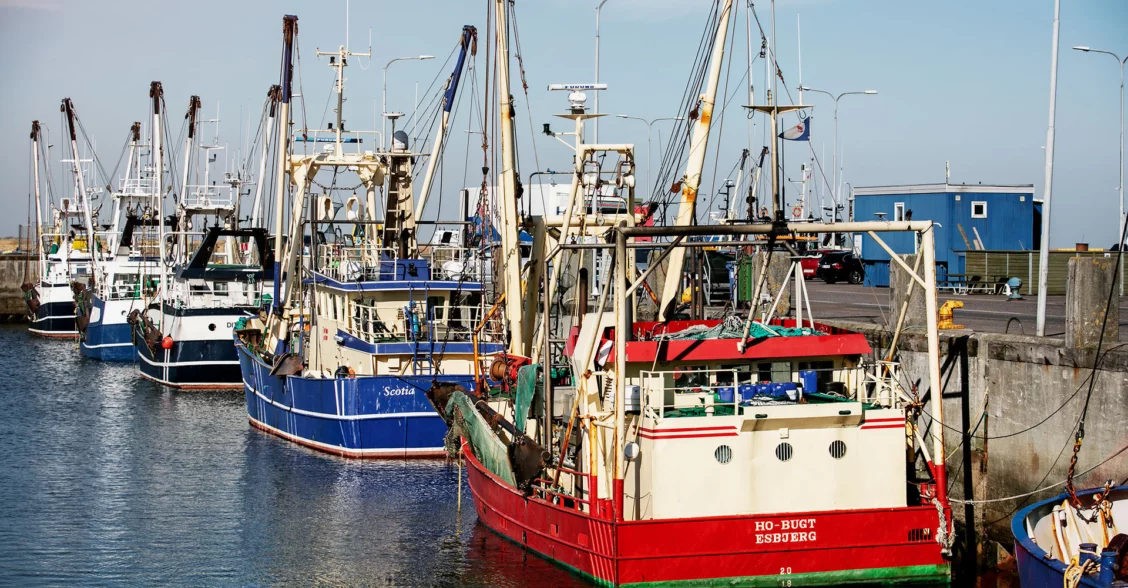Fishing has been the beating heart of the port of Esbjerg for over 150 years, and fishermen still land tonnes of fish, prawns and mussels every year. Now Port Esbjerg has initiated a new project to modernise the fishermen’s facilities, enabling them to develop their processes and making it easier for them to do business in a more climate and environmentally friendly way with the aid of floating bridges, shore-to-ship power and sorting facilities for marine litter.
Plastic and other marine litter are a regular part of the catch when Esbjerg’s fishermen pull in their nets from the sea. The idea is to make it even easier for the fishermen to sort and dispose of this form of litter when they return to shore.
“No one is more interested in a good marine environment than fishermen. We’ve always brought in the rubbish we catch in our nets, and now we’re going to sort it too. The fishermen at Esbjerg have welcomed the initiative, and I’m very proud of that,” says Jesper Juul Larsen, chairman of the fishermen’s association Sydvestjysk Fiskeriforening; Jesper himself has had a fishing vessel at Esbjerg for many years.
Port Esbjerg will collaborate with the fishermen on a major update of the facilities at the fishing harbour, including new sorting facilities for marine litter, floating bridges with shore-to-ship power and more quayside space, all of which will ensure that the fishermen not only contribute to a better marine environment, they will also have a better working environment themselves.
“We’ve got a strong fishing industry at Esbjerg, and we’d like that to continue. This will be a ‘best practice’ project on how to create a modern fishing harbour. And we’ve been very keen to design the initiatives in such a way as to benefit the fishermen as much as possible,” explains engineer and project manager Jesper Jørgensen of Port Esbjerg.

The habour is going to be updated for Esbjerg's fishermen.
Making the green choice the easy choice day to day
There is no easy way to future-proof a port. However, with good collaboration between all stakeholders at the port, we have found a good and robust solution, and we began by interviewing the fishermen and mapping their working practices.
“It was important to us from the beginning to take the fishermen’s everyday lives as our starting point. As a port, we’ve got to make it as easy and flexible as possible for our customers to do business. That’s why we start with the companies at the port when we’re looking to develop new solutions,” says Jørgensen.
For example, we discovered that floating bridges could make it easier for fishermen to get onto the quayside, and that they need space on the quayside to work with their nets, making it easier to switch between different types of fishing gear.
“Floating bridges and more quayside space may seem trivial, but such things can make a big difference day to day. It’s really about removing all the little barriers so everyone can work more efficiently and more safely,” explains Juul Larsen.

New environmental stations should make it easier for fishermen to sort the waste that is fished up from the sea.
Mapping the fishermen’s habits
The next step of the project is to map the fishermen’s habits in relation to the marine litter in order to establish the very best design of the new sorting facilities. This is about the types and quantities of the litter, and to that end, Port Esbjerg has enlisted the help of the organisation Naboskab, which specialises in social behaviour mapping.
“It’s a bit odd really to have someone walking around observing, but then it’s all about finding the best solution for everyone,” says Jørgensen.
Juul Larsen says that the fishermen have always been willing to adapt and that they have also welcomed the new project.
“It’s in our nature to be adaptable. The thing is there’s a lot of potential. It’s hard to say how much rubbish we get in our nets every year, but it's a lot, and now we can get it sorted for recycling. The new fishing harbour project will be very positive for the development of the fishing industry in Esbjerg,” says Juul Larsen.
If all goes to plan, the fishermen will have their new facilities by the summer of 2022. The project is undertaken with support from the Danish Civil Aviation and Railway Authority’s Ports and Fisheries Funds.
Go to overview

